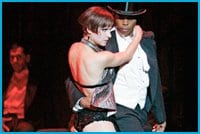“Boys with girls, boys with boys, girls with girls, men with boys and girls, women with men or boys or girls or tamed little panthers — what’s the difference? Let’s embrace each other! Let’s dance!”
Klaus Mann, 1942
“There was a cabaret and there was a master of ceremonies and there was a city called Berlin in a country called Germany. It was the end of the world and I was dancing with Sally Bowles — and we were both fast asleep.”
Cabaret
The metaphor of people dancing sensually yet fast asleep in the midst of social chaos continues to possess relevance in a gas-guzzling world torn apart by wars where people’s lives are destroyed daily. As we speed along highways, dodging heavy traffic on country roads, toward theatre festivals in small rural villages, eager to catch the latest cultural offering from revered summer festivals, we may become complicit in a global crisis. And what better fare for an entertaining and delightful evening of musical theatre?
Cabaret, considered the most influential musical of the second half of the 20th century, takes the metaphor “asleep at the wheel” and turns it into a cinematic riff that suggests that the world has become one mammoth, out of control, self-referential film about to self-destruct like celluloid sizzling in an overheated projector. Although effective as a visual through line, director Amanda Dehnert’s decision to present the audience with a burning cinematic image at the end of the current Stratford production does not pack the kind of punch the rest of the production provides. Nevertheless video designer Sean Nieuwenhuis’s series of filmic projections, combined with flawless performances by the principals, provide audiences with an extremely sexy and thrilling evening of sharp, menacing choreography and truly evocative musical prowess.
Bruce Dow’s master of ceremonies, although puzzlingly anachronistic in a Boy George-like oversized hat and ankle-length bright red coat, captures the audience’s attention at the outset and gives the show an enchanting tour guide of sorts, supervising a two-hour musical jaunt through the Berlin of Nazi Germany. Dow has a beautiful voice that could use a little more theatrics throughout, yet shines in the gorgeous ballad “I Don’t Care Much.” Nora McLellan’s Fräulein Schneider stops the show with the startlingly unapologetic, “So What?” But it is the role of Sally Bowles, played to perfection by Trish Lindström, that renders this production truly memorable. Her quirky, vivacious physicality and the narrative brilliance with which she infuses every line of dialogue and every song is captivating. The rest of the cast rounds out the production with incredibly strong voices and beautifully rendered choreography by Kelly Devine.
Highly effective video images and impeccable performances do not, however, culminate in a powerful ending. In a world still haunted by the spectre of anti-Semitism, racism and rampant capitalism, Cabaret must leave us with a powerful image that throws an unflattering light upon the world in which we live today, and in which we have lived for decades marked by constant war. A flickering screen image is simply not enough. More attention might have been paid to former stage and film productions of Cabaret to punctuate two hours of eerily entertaining mayhem with a self-reflective image that has us leaving the theatre with a potent reminder of our own roles in this ongoing horror flick. And then we can get in our cars and drive merrily home again because, after all, life is a cabaret old chum.

 Why you can trust Xtra
Why you can trust Xtra


